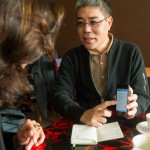On Using Social Media to Communicate Mission – Part 1
By James Higa, PVF Executive Director
“How do I use social media?” This just may be the question I am most often asked when visiting with PVF’s nonprofit partners. So I thought I would share some key lessons I have learned to effectively communicate in this new medium. PVF is in the business of relationships, and so it should come as no surprise that we constantly strive to be better at communicating – our mission, the needs of our community, and the work of our partners. Social media has been an important medium for PVF to utilize on this journey.
 It’s the message, not the tool. “How do I use Twitter or Facebook” is the wrong question. You may or may not need it. It depends on what you want to say. An ineffective message on a web page doesn’t get any better if you post it on Facebook. Step one is to ask if your message is as good as it can be. Start with your message, then determine the best way to communicate it.
It’s the message, not the tool. “How do I use Twitter or Facebook” is the wrong question. You may or may not need it. It depends on what you want to say. An ineffective message on a web page doesn’t get any better if you post it on Facebook. Step one is to ask if your message is as good as it can be. Start with your message, then determine the best way to communicate it.
Do you want to convey the excitement of the weekend rope climbing course for your youth? Pictures are better than words for that. Instagram may be the way to go or a YouTube video channel. Do you want to have people understand the efficacy of early reading programs? An eye catching info-graphic in a blog is probably best suited, or create a thought-provoking poll that can raise awareness on Facebook.
Pick your message. Then pick your tool.
Letting go. The history of marketing has been a command and control, top-down, broadcasting, blast and interrupt mode of reaching your audience. Think TV, radio, your web page. The modus operandi has been: first craft your on-point message, brand, and positioning statement, then blast it out to reach as many random people as you can.
Social media is not a top-down pyramid. It’s a complex and overlapping mesh of relationship networks. It’s a fundamental re-architecting of the Internet. The Web is being rebuilt around people. I have my circle of friends from college. I have my circle of friends from when I lived in Tokyo. I have my circle of friends in technology. No one else can pass a message along from one of these networks to the other. Now blow that image up to every single person’s overlapping circles and you get some sense of this emerging structure.
In that chaotic structure, you should stop looking for influentials with a humongous following to re-broadcast your message. Finding them is too hard and too expensive. When American Eagle made it easy to share the clothes you liked with your friends on Facebook, they saw a 57% increase in sales. Finding and dropping conversations into these thousands of everyday small personal network groups is more likely to propagate your message. (For a more in-depth look at this theme, there is a gem of a book that you should read ‘Grouped’ by Paul Adams.)
A Twitter handle or a Facebook page controlled by your single marketing/communications director defeats the purpose of attempting to reach personal networks. This is why most feeds feel like the same old impersonal PR wire, full of corporate speak. Let go of the central command and control. Let every employee Tweet, post to Facebook, start an Instagram photo feed, and talk to your constituents’ personal social groups. But what if they say something inappropriate? Yes, they will, and they will learn. Instead, you might channel Tony Hsieh, CEO of Zappos. Every employee there is encouraged to tweet because every employee can affect the brand image and every employee needs to learn to be a Zappos brand manager.
Let go and trust your people.
These lessons learned by innovative businesses can also be followed by nonprofits. When all is said and done, the key to effective use of social media is about rebuilding your communication around people and communities, not around the technology. Start an ongoing conversation, not a broadcast. Reach people through personal messages across personal networks, not through a one-size-fits-all communication strategy.
The work of PVF is all about relationships – with and between grantees and donors and colleagues and the community. It is only fitting that our advice for using social media places the emphasis on the social.
Want to know more? Click here for part 2!





